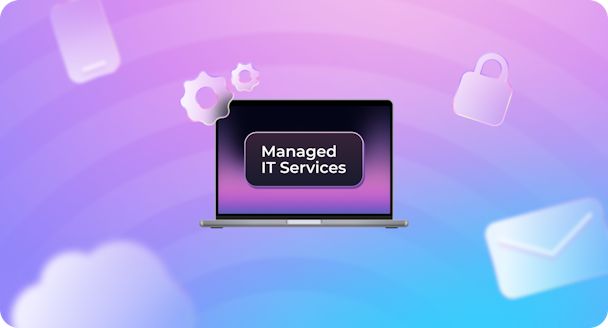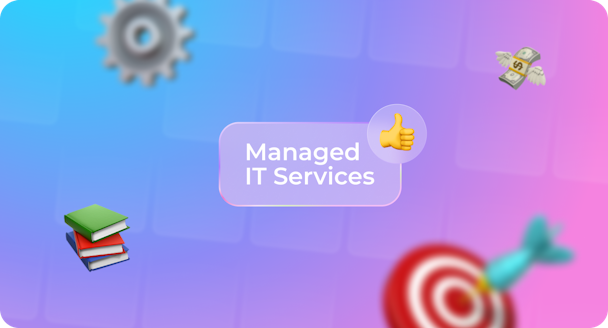What is managed IT service?
It’s hard to run a business without at least a computer, tablet, and smartphone these days. So, what do you do when something on one of those devices doesn’t work right? Typically, if you worked for a large company, you’d go to IT admins and ask them for help. But if you’re running a small or medium-sized business, you might not have those experts on board. So, finding a managed service provider might be your solution to that problem.
Keep reading to learn all about managed IT service providers, what services they provide, and where you can find one.

Managed IT service defined
Simply put, managed IT services are services a company outsources to a vendor. It can be small tasks that need to be done regularly, extensive infrastructure roll-out services, or assisting the in-house IT team with extra support after hours.
The needs of your business don’t always match up with the resources you have. Whether that is money to hire more people or the lack of the right skillset on your team, that is, literally, a definition of managed service providers or MSPs.
What does IT managed services include?
There’s no right or wrong answer to this question. You’ve already read about a few small examples, but here are some more common things you can turn to an MSP for:
- Managing hardware and infrastructure
- Security services like monitoring, penetration testing, or incident response
- Setup and day-to-day support for cloud services
- Communications support like VOIP services
Benefits of using managed IT services

There are tons of great benefits to using a managed IT service in your organization. A few of the big ones include:
- Cost savings. MSPs can save you money on full-time staff and training. Having a fixed monthly charge can be easier and cheaper than building an in-house team.
- Extra support. If your team is maxed out and running on fumes, asking them to work after hours can be too much. MSPs can provide additional support at a lower cost.
- Filling the skill gap. Managed services are often attached to specific cloud services, platforms, or software. Meaning you’re getting support from subject matter experts.
- Reliability. Your internal team has a million things to worry about, but your MSP is only worried about one specific piece of infrastructure or service so that they can give it their full attention instead of sharing it with the rest of your company’s IT needs.
Difference between managed services and cloud services
Often, you’ll see “managed service” appear next to “cloud service.” Or, to make matters worse, you might even see them lazily interchanged. But the truth is they are two very different things.
Cloud service is storage like the Google Suite or a platform like Jamf operating in the cloud. And an example of a managed service would be the support you enroll in for those specific services.
Recap: You can get managed services to support cloud service, but they’re not the same thing.
How to choose a managed IT service provider

When it comes to finding a managed service provider, your primary task is to find the right one. Many of them will offer all the bells and whistles, but that could be naught if they provide the things you don’t need.
Here are a couple of things to keep in mind when doing your due diligence on MSPs:
- Help solve your problems
It’s easy to get excited when you see a list of possible services and dream of all the possibilities a particular MSP can help you with. But the truth is if you’re looking for a managed service provider, then you probably have a specific need — or maybe even multiple ones. Write those things out to have a clear understanding of what you’re looking for.
A good service provider will be great at a lot of things. But they’re of no use if they’re not good at the one thing you need.
- Contracts and agreements
Whenever you hire a managed service provider, you must sign a contract. That’s when you need to have clearly defined terms and service level agreements, or SLAs. You’ll need to protect your company by outlining detailed conditions that will help you hold the service provider accountable. Include the timeframes, system performance levels, and scope of responsibilities. Ultimately, terms and SLAs will protect the service provider and your business.
- Strategic planning and auditing
Even though you’re contracting out this portion of your company to a service provider, the truth is you want more of a partner. At the end of the day, the MSP will be responsible for service. They should want to help set you up for success and ensure that workflow is perfectly optimized.
- A good track record
This one is a bit more obvious, but because someone offers a service doesn’t mean they’ll be great to work with. Always check out the reviews and ask for recommendations from MSPs to help find the ones that will work best for you.
Using managed IT services is a great way to ease up some of the workloads on your in-house team or even fill in some of the gaps your company currently has. But finding the right one to partner with you and your business can make all the difference. So, before you sign an agreement with anyone, determine what kind of help you need. Do your research, and you’ll rest assured knowing you’ve got the right expert in your corner.







